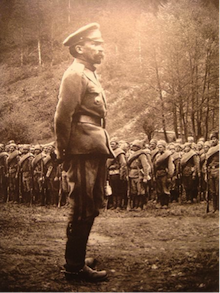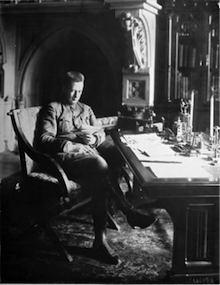

|
Kerensky and Kornilov  General Kornilov After the July Crisis Kerensky was hailed as the man to reunite the country and halt the drift towards civil war. He was the only major politician who had a base of popular support yet who was also broadly acceptable to the military leaders and the bourgeoisie. On 8 July he became Prime Minister. The programme of the new coalition government (formed on 25 July) was no longer based on Soviet principles, as had been agreed in February. On the Kadets' insistence, Kerensky passed tough new restrictions on public gatherings, restored the death penalty at the Front and agreed to roll back the influence of the soldiers' committees to restore military discipline. The head of the army, General Kornilov, appeared as the 'national saviour'. He demanded a series of measures that effectively amounted to the imposition of martial law. Kerensky agreed to satisfy his demands, leading Kornilov to expect the reformation of the Provisional Government as a military dictatorship headed by himself. Hearing rumours of a Bolshevik uprising to prevent this coup, Kornilov sent a Cossack force to occupy the capital, disperse the Soviet, and disarm the garrison. At this point Kerensky turned against Kornilov, condemning him as a traitor to the revolution and appointing himself as Commander-in-Chief in his place. The Soviet executive established an all-party committee to mobilize forces for the defence of the capital. It marked the political rehabilitation of the Bolsheviks after the July Days - and several prominent Bolshevik leaders, including Trotsky, were released. Only the Bolsheviks had the ability to mobilize and arm the mass of the workers and soldiers.  Kerensky in the Winter Palace Throughout the northern industrial regions ad hoc revolutionary committees were formed to fight the 'counter revolution'. Red Guards organized the defence of the factories. The Kronstadt sailors, who had last come to Petrograd during the July Days to overthrow the Provisional Government, arrived to defend it. There was no need for fighting in the end. On their way to Petrograd the Cossacks were met by a Soviet delegation and persuaded to lay down their arms. Kornilov was imprisoned with thirty other officers in the Bykhov Monastery near Mogilev for having been involved in a 'counter-revolutionary conspiracy'. Viewed by the Right as political martyrs, these 'Kornilovites' were later to become the founding nucleus of the Volunteer Army, the major White force of the civil war. The 'Kornilov Affair' undermined Kerensky's position. Condemned by the Right for betraying Kornilov, the Prime Minister was widely suspected on the Left of having been involved in his 'counter-revolutionary' movement. The mass of the soldiers suspected their officers of having supported Kornilov, and for this reason a sharp deterioration in army discipline resulted. Soldiers assemblies passed resolutions for Soviet power and peace. In the weeks following the Kornilov crisis the rate of desertion sharply increased, with tens of thousand leaving their units every day. Most of the deserters were peasants, eager to return to their villages, where the harvest season was now in full swing. In the big industrial cities there was a similar process of radicalization in the wake of the Kornilov crisis. The Bolsheviks were the principal beneficiaries of this, winning their first majority in the Petrograd Soviet on 31 August, the Soviets of Riga, Saratov and Moscow falling to them shortly afterwards. The rising fortunes of the Bolsheviks was essentially due to the fact that they were the only major political party which stood uncompromisingly for Soviet power. |
© 2014 Orlando Figes | All Rights Reserved